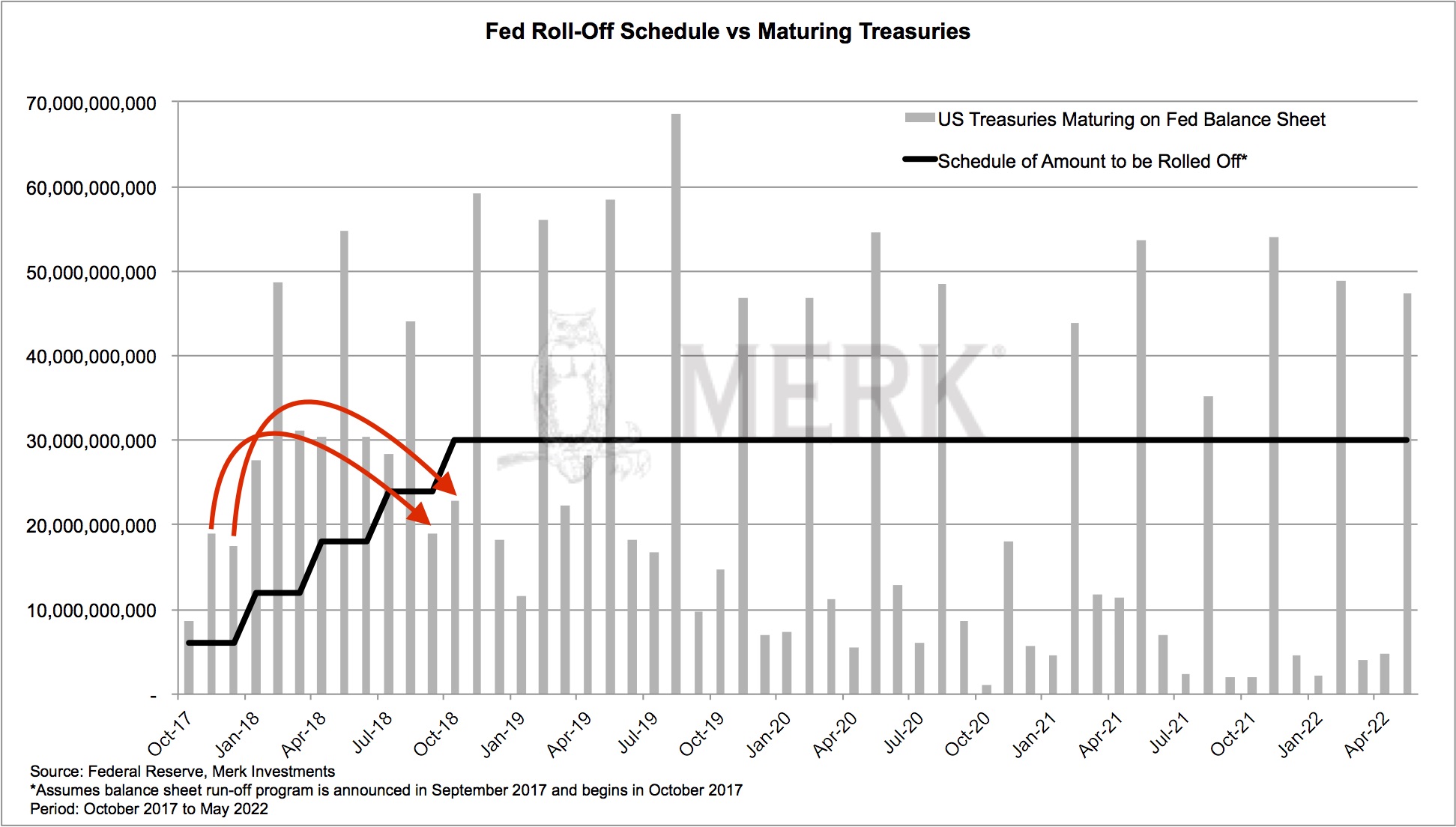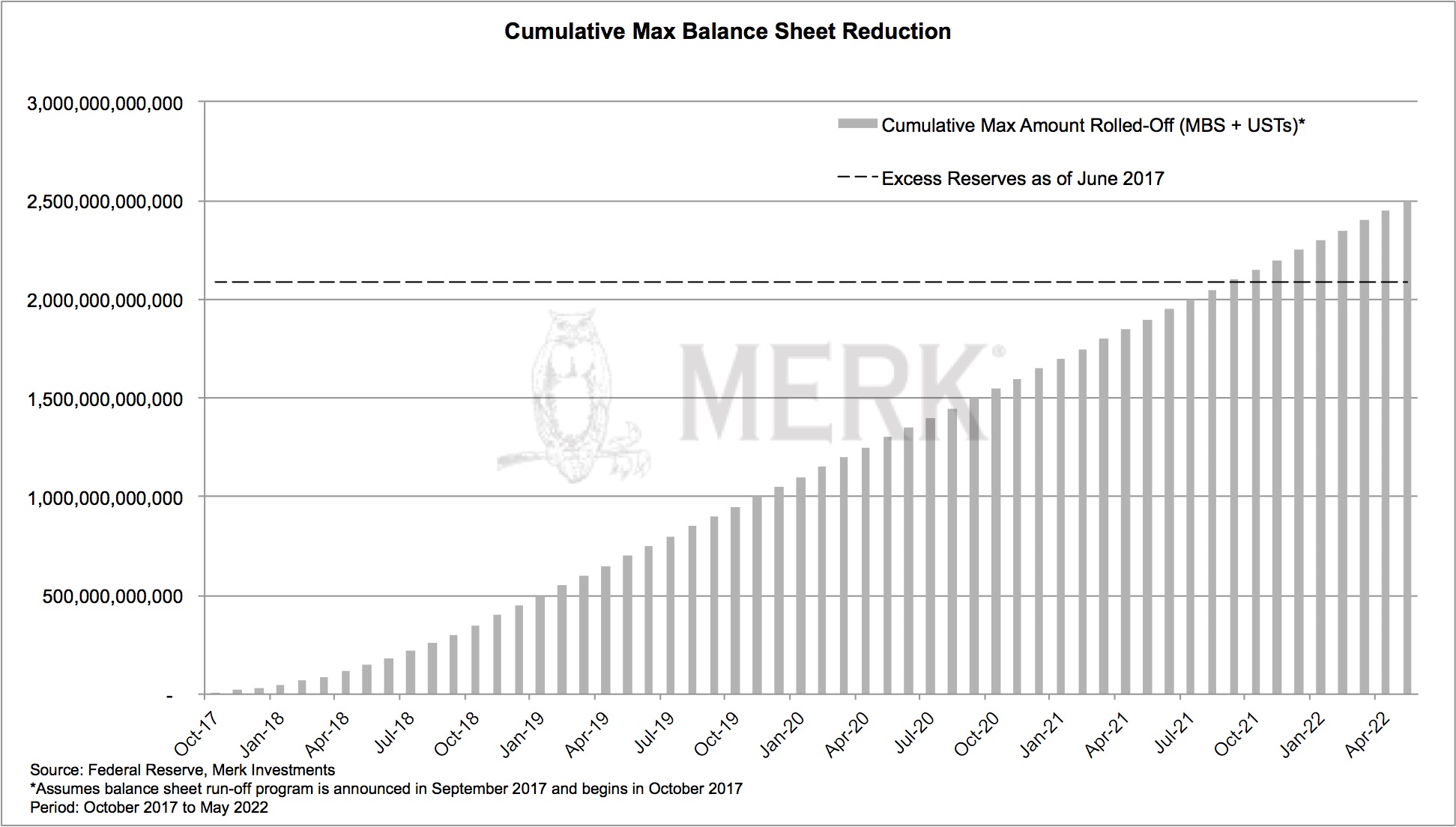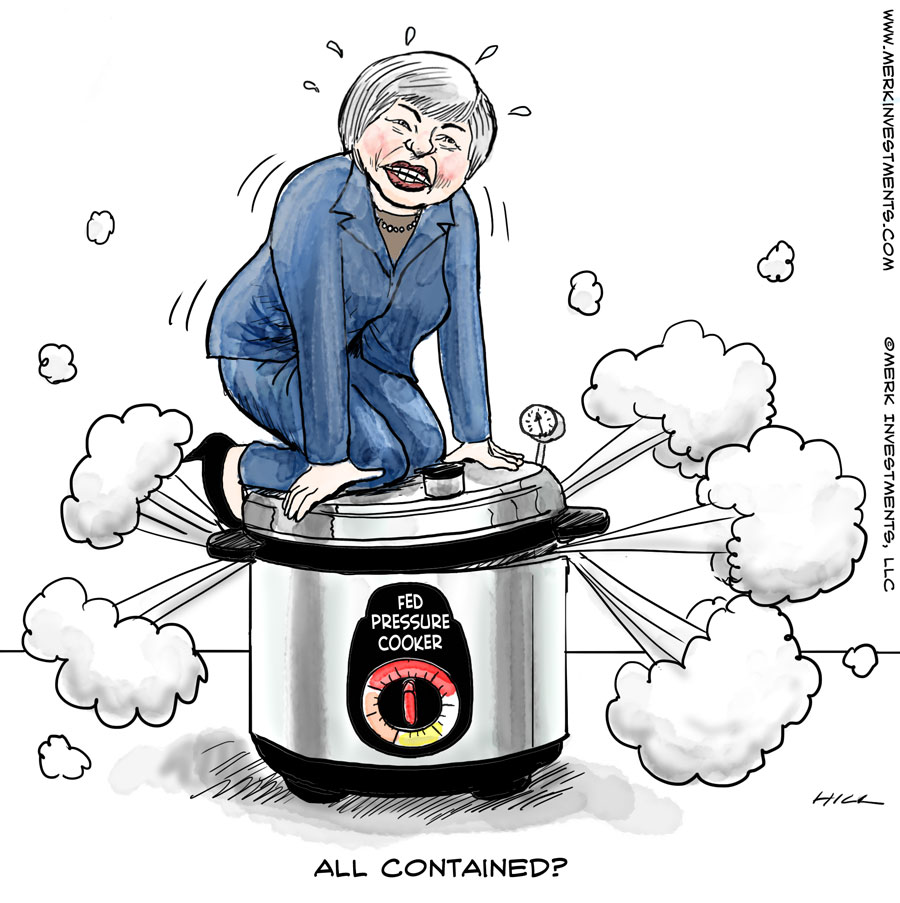What's next for the dollar, stocks, bonds & gold? Axel Merk, Merk Investments July 12, 2017 The Fed’s “balance sheet reduction” may have profound implications for the dollar, gold, stocks and bonds. We provide an outlook. It is said forecasts are difficult, especially when they relate to the future. Investors might want to pay attention nonetheless, not so much because I believe I have a crystal ball, but because investing is about managing risk. And there’s a risk that I’m right. Quantitative Tightening In addition, the Fed will allow mortgage-backed securities to run off (MBS). There’s really no good reason to look at Treasuries and MBS in isolation; as such, the balance sheet reduction would be $50 billion a month if the program were to be fully deployed: The Fed hasn’t announced how small a balance sheet they want to have; based on our interpretation of discussions of current and former policy makers, this is because the Fed neither knows, nor agrees of where they want to take the balance sheet. It apparently doesn’t stop the Fed from preparing the markets that they embarking on this journey because they believe they have years to make up their mind. Notably, as can be seen from the chart above, they might have until 2021. Basically, the Fed can reduce its balance sheet until excess reserves have been eliminated (this level varies on economic activity; the dashed line represents the current level of excess reserves and the potential maximum reduction holding all else equal). Whether the Fed will try to get excess reserves to zero or some other amount is an open question that not even the Fed appears to be able to answer internally. If reducing the Fed’s balance sheet at a rate of $50 billion a month is akin to watching paint dry, what then is the ECB’s activity of purchasing €60 billion a month (its current rate)? Either the Fed or the ECB is pulling our leg here. If printing money is quantitative easing (QE), then balance sheet reduction is quantitative tightening (QT). There has been a lot of debate of what sort of impact QE actually has. Skeptics of QE have pointed out that all bonds trade relative to one another, i.e. an MBS might be a substitute to a Treasury bond which in turn might be a substitute to a German bund; applying a given spread, one can take that exercise further to any number of seemingly “safe” bonds, recognizing that safety is not an absolute concept (and from a US regulatory point of view, only US Treasuries are considered “safe” as the US government can always print money to pay it back). It’s in this context that the buying of MBS has been criticized as a useless digression from monetary into fiscal policy. Useless because spreads between MBS and Treasuries haven’t been meaningfully impacted; and a digression into fiscal policy because buying MBS rather than Treasuries is fiscal policy given that credit is allocated to a specific sector (housing) of the economy, something in the domain of Congress, not the Fed. So has Yellen suddenly become a critic of QE by suggesting QT is akin to watching paint dry? I doubt it; much rather, the Fed does what it continuously has been doing since the financial crisis: try to convince the markets with words. If the Fed tells you, rates rather than QT is the primary tool to set rates, it must be true, right? Please just look at the rates, ignore everything else. In the meantime, across the pond at the ECB, Draghi will tell you with a stern look that QE is responsible for everything good that has happened in the Eurozone (and that he isn’t responsible for any bad side effects). You shall be excused if you are scratching your head. It’s all about risk premia I’m not alone with this theory; the Fed and other central banks appear to have been petrified that stepping back from ultra-accommodative policies would cause a major revolt in the market. But then magic happened: the market presented the Fed rate hikes on a silver platter. And with two rate hikes out of the way this year, the markets are still holding up. As the markets are holding up, central bankers feel like day traders on a winning streak: they must be geniuses! Borrowing from the picture depicting Yellen on the pressure cooker above, though, I would caution central bankers not to do a victory lap quite yet. In my mind, to stay with the analogy, some steam has been let out of the pressure cooker; and with the Fed ever more falling behind the curve, the illusion may have been created that real interest rates are moving higher, when indeed only nominal interest rates are moving higher. With QT, think about the pressure cooker shrinking while the contents remain the same; if the content of the pressure cooker is a bunch of hot air, it is well possible to further compress it. What I’m arguing here is that QT will increase risk premia. Before we discuss implications of rising risk premia, let’s consider what’s happening at other central banks. The real elephants The ECB’s program to purchase €60 billion in securities each month is running through the end of this year. As such, the market is expecting that in September, possibly a bit later, the ECB is going to announce what will happen thereafter. It appears Mr. Draghi, possibly emboldened by what’s happening at the Fed (although central bankers would never express it this way; it’s of course domestic considerations they are evaluating), he recently said: You read this correctly: the ECB will remove accommodation, but it won’t really and it won’t call it tightening. Think: watch paint dry on the wall. He tried to pull a Yellen! You can’t make this stuff up. In some ways, it reminds me of the dot-com bubble, where companies told analysts what to write into their reports, so as to avoid the necessity for analysts to actually do any thinking of their own. Except the market didn’t take Draghi’s bluff and German Bunds sold off. Less than a year ago, Bunds traded at negative yields; in the aftermath of Draghi’s comments, they surged from roughly 0.25% to over 0.50%. A big jump for those that watch those markets. In contrast, U.S. Treasuries are yielding 2.37% as of this writing. Historically, the spread between U.S. Treasuries and German Bunds are highly correlated to the exchange rate between the Euro and the U.S. dollar. As German Bunds are falling (yields rise), the euro has had a tendency to rise when U.S. long-term rates don’t move much. Not surprisingly, the euro has rallied quite a bit as part of this ECB induced mini taper tantrum. To assess where we go from here, consider the following:
Other central banks around the world may also be emboldened to take the foot off the accelerator. The biggest potential to catch up may well be in Sweden, where we have said for years that policy is too accommodative. You can call the weak dollar a deflating Trump trade, but the Fed may well have initiated a far greater force by enabling other central banks to tighten. Well, don't count on Japan to follow suit just yet. Implications for stocks Outbursts in the tech sector are, in the opinion of yours truly, the canary in the coal mine. The buy-the-dip mentality is wearing thin. Similarly, the end of day buying that had become routine may have turned into end-of day selling on several occasions of late. Does that mean that there isn’t value out there somewhere? Possibly, but don’t come crying to me if you lose money holding stocks in this environment. Implications for gold Closing thoughts on Fed balance sheet Follow me at twitter.com/AxelMerk. If you believe this analysis might be of value to your friends, please share it with them. Axel Merk |





